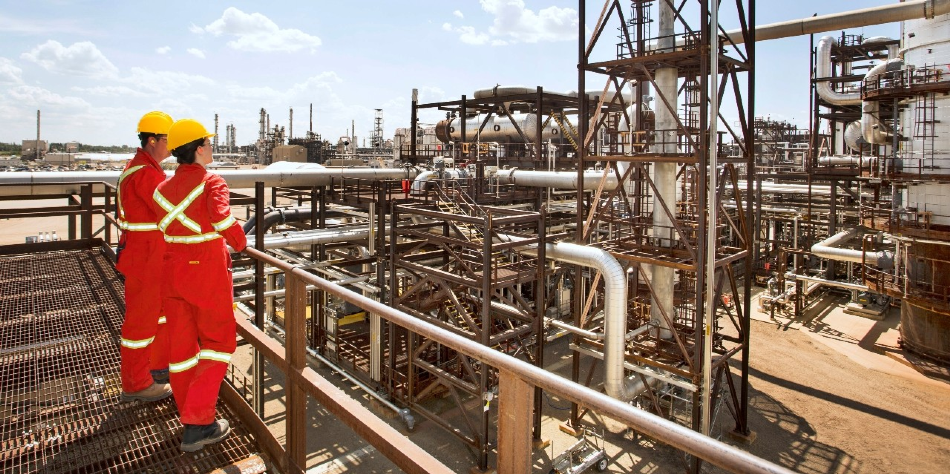Jan 20 2020
A research team at the University of Alberta has come up with several methods that can save a great deal of time when producing highly efficient carbon capture technologies.
 Workers at the Quest carbon capture and storage facility in Fort Saskatchewan, Alta. U of A researchers devised a process that dramatically reduces the time needed to develop carbon capture technologies, which could help bring down the costs of using those technologies and increase the likelihood that they will be adopted by industry. Image Credit: Shell Canada.
Workers at the Quest carbon capture and storage facility in Fort Saskatchewan, Alta. U of A researchers devised a process that dramatically reduces the time needed to develop carbon capture technologies, which could help bring down the costs of using those technologies and increase the likelihood that they will be adopted by industry. Image Credit: Shell Canada.
These methods will not only help in reducing the costs of using the technologies, but will also help in boosting their adoption as a means to mitigate the emissions of carbon dioxide (CO2).
At the University of Alberta, engineering professor Arvind Rajendran and his research team have created a two-step screening procedure that evaluates zeolites—carbon capture materials—within seconds instead of one day.
Such carbon capture materials work by adsorbing—essentially adhering to—CO2, just like how odors are trapped by charcoal filters used in common refrigerators. In the case of carbon capture systems, the “flue-gas” exhaust discharged by a power plant can be allowed to travel via the zeolites, so that it can capture the CO2 before it is released into the air.
At the theoretical level, an unlimited number of a variety of materials is capable of adsorbing CO2. However, as part of an industrial process, a molecule needs to be efficient and adhere to CO2. It should also discharge the CO2 on command when the gas has to be utilized or trapped.
But all zeolites are not equal, explained Rajendran’s research team. A few zeolites are relatively better than others at adhering to and discharging the CO2 gas.
The research team, which included master’s graduate Vishal Subramanian Balashankar, evaluated as many as 120,000 zeolites and effectively narrowed them down to just 7,000. With the help of conventional techniques, the remaining zeolites can be subsequently screened down to two dozen excellent targets.
Among these, one material seems to be a major enhancement on the existing regular material called zeolite-13x, and led to a more efficient power use of 17%.
The second tool made use of the known data about the carbon-capturing molecules to estimate the performance and behavior in a real-world system. This tool was jointly developed with engineering professors Vinay Prasad and Zukui Li from the University of Alberta as well as graduate students Kasturi Nagesh Pai and Gokul Subraveti.
Rajendran noted that the use of a machine-learning algorithm prevents the need to replicate the performance of every molecule. Consequently, the computational load is reduced by a factor of 10 without compromising precision.
While carbon capture technologies can prevent natural gas and coal power plants from discharging CO2, power companies are hesitating to use these technologies because, at present, they cost too much to set up and operate.
Our role is to provide these tools to help chemists find better molecules, and our expertise is designing processes that use the molecules to capture carbon.
Arvind Rajendran, Engineering Professor, University of Alberta
Identifying the right materials that can be accommodated into this Goldilocks zone has constantly posed a problem. However, the latest machine-learning tools developed by the group are pointing scientists to new, practical carbon capture materials, saving months spent on working with inefficient materials, or months lost to dead ends.
In addition, the machine-learning tools are assisting engineers to figure out the kind of carbon capture design that would be optimally efficient.
If adsorbents are compared to charcoal filters used in refrigerators, then machine learning can assist the scientists to interpret the type of brands that are highly effective at capturing odors, and how the incorporation of these brands in the refrigerator can alter the impact.
The conventional process of reaching these decisions was not quick and depended largely on elaborate computer simulations and arduous work. Every promising system design and every potential molecule had to be separately replicated, needing excellent computing power.
The point is to quickly find molecules and systems that will reduce the cost of capturing carbon, to bring it down well below the carbon tax so it actually gets adopted.
Arvind Rajendran, Engineering Professor, University of Alberta
Recently reported in ACS Sustainable Chemistry & Engineering and Industrial & Engineering Chemistry Research, the methods can be adapted to expedite discoveries regarding other types of processes and materials relevant to climate change as well as industrial gas separations, such as purification of oxygen and upgrading of methane—topics that are presently being studied by the researchers.
We need renewable sources of energy, but we will have these hydrocarbon systems for years to come. This technology can stop emissions now, and buy us time to complete the transition.
Arvind Rajendran, Engineering Professor, University of Alberta
Rajendran’s study was supported by the University of Alberta’s Future Energy Systems program and Compute Canada.